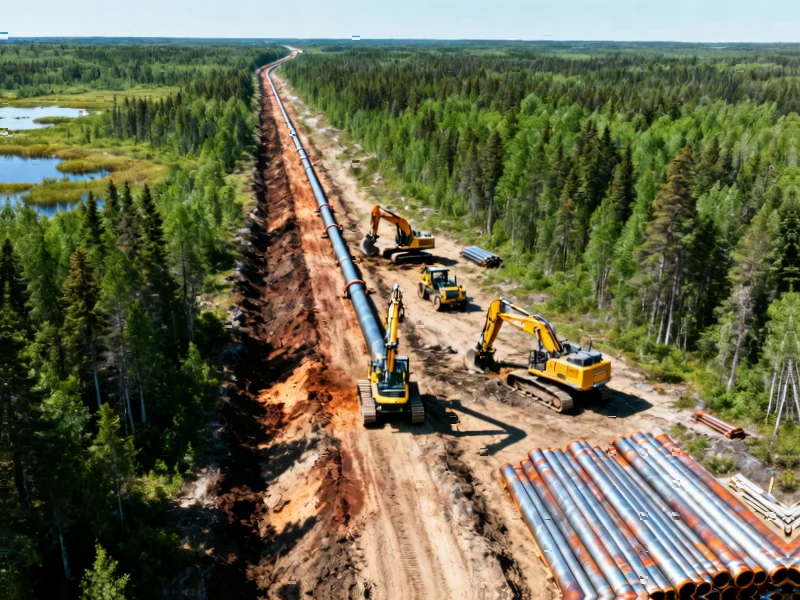According to Manufacturing AUTOMATION, the Ontario government awarded a contract on October 30, 2025 to complete a feasibility study for a new Canadian East-West pipeline and energy corridor. The study will explore building pipelines using Canadian steel to transport Western Canadian oil and gas from Alberta and Saskatchewan to refineries in southern Ontario and new ports on James Bay, Hudson Bay, and the Great Lakes. Ontario Premier Doug Ford called it a “nation-building pipeline” that would reduce dependence on the United States amid tariffs, while Alberta Premier Danielle Smith praised the provincial cooperation. The feasibility study will be completed next year, evaluating corridor options, costs, and complementary development opportunities including Ring of Fire roads and mineral exports, with commitments to consult Indigenous communities. This ambitious proposal represents a significant shift in Canadian energy strategy that warrants deeper examination.
Table of Contents
The Geopolitical Imperative
This pipeline proposal emerges against a backdrop of increasing trade tensions and energy security concerns. For decades, Canada has exported over 90% of its oil to the United States, creating significant market concentration risk. Recent US tariff policies have exposed this vulnerability, prompting Canadian policymakers to seek alternative routes and markets. The timing is particularly significant given global energy market realignments following Russia’s invasion of Ukraine and shifting Middle East dynamics. What’s notable here is the explicit framing as “nation-building” infrastructure – language reminiscent of historical Canadian projects like the transcontinental railway that were designed to bind the country together economically and politically.
Massive Engineering Hurdles
The technical challenges of building a pipeline across northern Ontario cannot be overstated. The proposed route would traverse some of Canada’s most challenging terrain, including the Canadian Shield’s rocky landscape and extensive boreal forest. Pipeline construction in these conditions requires specialized engineering solutions for permafrost regions and environmentally sensitive areas. The mention of ports on Hudson Bay introduces additional complexity – these waters are ice-bound for much of the year, requiring ice-breaking tankers or seasonal operations that limit economic viability. Previous attempts to develop northern energy infrastructure have often stumbled on these exact technical and logistical challenges.
Questionable Economic Fundamentals
While the political rhetoric emphasizes energy independence and job creation, the economic case remains unproven. Building an entirely domestic pipeline system using only Canadian steel and labor would likely result in significantly higher costs compared to existing cross-border infrastructure. The distance from Alberta’s oil sands to southern Ontario refineries is approximately 3,400 kilometers – substantially longer than routes to US Gulf Coast markets. Additionally, Ontario refineries are optimized for lighter crude, while Alberta produces heavier grades that require expensive upgrading or specialized refining capacity. The feasibility study must address whether Canadian consumers would bear these additional costs through higher energy prices.
Indigenous Consultation Realities
The commitment to “honour its duty to consult with Indigenous communities” represents one of the project’s most critical challenges. Northern Ontario is home to numerous First Nations communities whose traditional territories would be directly affected. Recent Canadian court decisions have strengthened Indigenous rights regarding resource projects, making meaningful consultation and accommodation essential rather than optional. The mention of “Indigenous equity participation” suggests recognition that mere consultation may be insufficient – true partnership will be necessary. However, achieving consensus among diverse Indigenous communities with varying perspectives on resource development presents a formidable political and logistical challenge that has derailed similar projects.
Environmental and Regulatory Hurdles
This project would inevitably face intense environmental scrutiny at a time when Canada has committed to ambitious climate targets. Pipeline construction through pristine northern ecosystems would raise concerns about habitat fragmentation, waterway crossings, and potential spills in sensitive areas. The federal government’s impact assessment process has become increasingly rigorous, requiring demonstration of how major projects align with climate commitments. Additionally, linking this infrastructure to the Ring of Fire mineral development creates a cumulative impact assessment challenge that could prolong regulatory timelines and increase costs beyond initial projections.
Shifting Energy Market Realities
The fundamental assumption underlying this project – that demand for Canadian fossil fuels will remain strong – faces challenges from the global energy transition. Many international markets that might be accessed through new northern ports are implementing policies to reduce oil consumption in coming decades. Meanwhile, electric vehicle adoption and decarbonization of industrial processes could reduce domestic demand in the very markets this pipeline aims to serve. The 2025 feasibility study completion timeline means shippers would need to commit to this infrastructure based on projections that may not account for accelerating energy transition policies being implemented globally.
Realistic Project Outlook
Based on historical precedent for major Canadian energy infrastructure, the path from feasibility study to operational pipeline typically spans a decade or more, assuming all regulatory, legal, and political hurdles are overcome. The explicit provincial cooperation between Ontario, Alberta, and Saskatchewan provides political momentum, but federal approval and financing would still be required. More likely outcomes include scaled-down versions focusing on specific segments or complementary infrastructure like the mentioned all-season roads and grid upgrades. The ultimate test will be whether private sector partners emerge willing to commit billions in capital to a project facing significant technical, economic, and regulatory uncertainty.



